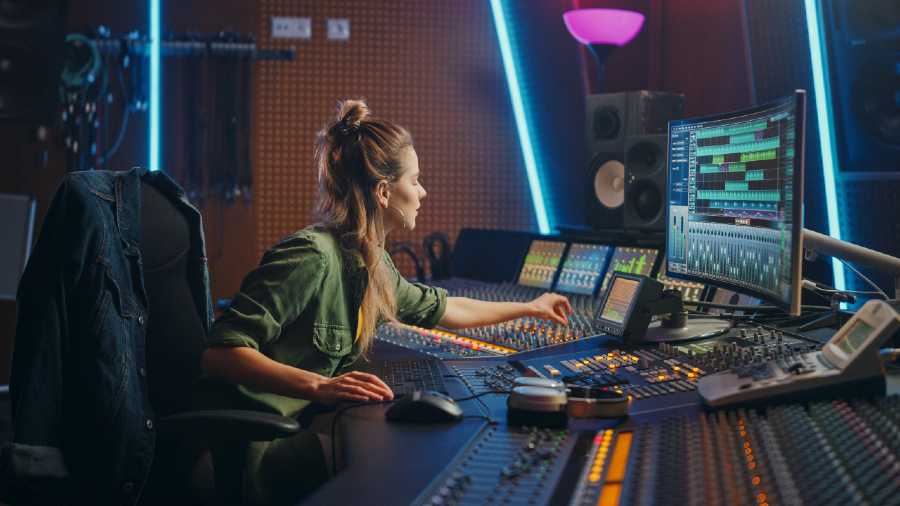Sound is an art and a craft that many people appreciate but few know much about. It is the power of great sound that enhances the experience of a film, adds texture and detail to scenes, and has the power to send the audience on an immersive journey.
Today, music and audio experiences are a huge part of the consumers’ lives. People have access to music and podcasts or watch television and movies at home or on the go, making digital audio technology our closest companions.
“Sound design can be thought of as the unspoken hero of a film,” says Glenn Kiser, senior director of Dolby Institute-Dolby Laboratories, US.
Sound design is a creative and immersive art form used in various disciplines such as filmmaking, television production, theatre, live performance, video game development, sound recording and reproduction, post-production, radio and musical instrument development.
A sound designer, thereby, plays an unequivocally important role in bringing all these elements together.
A sound engineer must be proficient with the technical know-how and have expertise in operating involved systems and associated workflows. He or she must come with training as well as experience in the production and manipulation of sound through mechanical (analog) or digital means.
Says Saibal Ray, teaches the technical aspects of sound designing at the Adamas University School of Media and Communication, “Cinema uses sound engineering to a great extent. Suppose the sound designer wants to add sound to a visual of a helicopter; to do this one has to collect the sound first. For this one has to understand the set-up. If the sound of a helicopter exceeds the dynamic range of the recorder, one needs to put a limiter on the recording path to tame the sound...”
According to Ray, typically, in a film project sound is managed by the location sound recording engineer, the sound designer and the mixing engineer. A location sound recording engineer is responsible for the recording sound on location. A sound designer is responsible for the creative design part of the sound track that incorporates music as well. It is to be mentioned here that though music is a part of soundtrack, it is supervised solely by musicians and is not part of the sound department. Finally, the mixing engineer or the re-recording engineer mixes all the tracks to prepare the final output to be combined with the edited visuals. Each of these three heads generally has a team.
Clive D’Souza, who completed his bachelor’s in audio engineering, from Australia’s SAE Institute, says, “Currently I’m more into installations and configuring of audio-visual systems and some of my projects are multi-purpose halls, cinema, acoustics, background music systems, one opera house, recording studios, live sound rentals, and home automation... I would say that this is not a very fast paced income industry unless you are into film audio work.” D’Souza is working with the Hitec Center in Oman.
A course in sound engineering will be suitable for and extremely beneficial to students who have an interest in the art of sound and want to learn different technicalities related to the subject. There are many diploma level courses available, anything between six and 12 months’ duration. For a course in sound engineering, a background in physics and mathematics is preferable. A good ear for sound as well as knowledge and interest in music will be an added advantage.
Institutes that offer courses in sound engineering: Film and Television Institute of India, Pune; Satyajit Ray Film and Television Institute of India, Calcutta; Whistling Woods International, Mumbai; MIT School of Film and Television, Pune; SAE Technology College, which has campuses across India; Ramoji Academy of Film and Television and Annapurna College of Film and Media, both in Hyderabad.
Some jobs that you can pick from: sync-sound recording professional, sound designer, mixing engineer for cinema, installation engineer, studio sound engineer, live sound engineer, studio designer, music arranger, audio post-production, dialogue and music editor, location recordist.
Sound Bite

Resul Pookutty Wikipedia
After a BSc in physics, Resul Pookutty pursued law for a bit and, thereafter, applied for a sound engineering course at the Film and Television Institute of India, Pune. He made his debut in sound design with the 1997 film Private Detective: Two Plus Two Plus One, directed by Rajat Kapoor. His big break, however, was Sanjay Leela Bhansali’s Black. He has been known to say in interviews that he grew up on a rich tradition of Malayalam films wherein sound represents the cultural context. Pookutty got the Academy Award in 2009 for Best Sound Mixing — along with Ian Tapp and Richard Pryke — in Slumdog Millionaire. He recorded the soundscapes of Mumbai. It was reported at the time that in one sequence he used 25 microphones for his sound harvest. In his Oscar speech he said, “This is not just a sound award but a piece of history that has been handed over to me...” Pookutty has time and again stressed that the job of a sound artiste is to create an “immersive experience”. Today, he has his own post-sound facility and has also created a library of sound effects called The Essential Indian Sound Effects.











